Wichita, Kansas
Wichita (/ˈwɪtʃɪtɔː/ WITCH-i-taw)[8] is the largest city in the U.S. state of Kansas[5][9] and the county seat of Sedgwick County. As of 2018, the estimated population of the city was 389,255.[6] Wichita is the principal city of the Wichita metropolitan area which had an estimated population of 644,888 in 2018.[10][11]
Wichita, Kansas | |
|---|---|
City and county seat | |
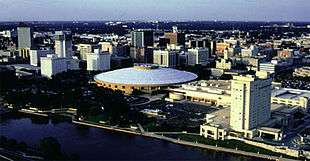  Clockwise from top: Downtown skyline, Eck Stadium, The Keeper of the Plains sculpture, Sedgwick County Zoo Gorilla Village, Exploration Place | |
 Flag  Seal | |
| Nickname(s): | |
 Location within Sedgwick County and Kansas | |
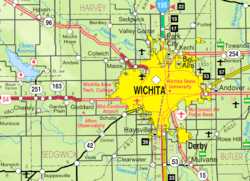 KDOT map of Sedgwick County (legend) | |
| Coordinates: 37°41′20″N 97°20′10″W[3] | |
| Country | United States |
| State | Kansas |
| County | Sedgwick |
| Founded | 1868 |
| Incorporated | 1870 |
| Named for | Wichita people |
| Government | |
| • Type | Council-Manager |
| • Mayor | Brandon Whipple (D) |
| • City Manager | Robert Layton |
| Area | |
| • City and county seat | 163.59 sq mi (423.70 km2) |
| • Land | 159.29 sq mi (412.56 km2) |
| • Water | 4.30 sq mi (11.14 km2) |
| Elevation | 1,302 ft (397 m) |
| Population | |
| • City and county seat | 382,368 |
| • Estimate (2018)[6] | 389,255 |
| • Rank | US: 51st KS: 1st Midwest: 10th |
| • Density | 2,300/sq mi (900/km2) |
| • Metro | 644,888 (US: 89th) |
| • CSA | 672,796 (US: 74th) |
| Demonym(s) | Wichitan |
| Time zone | UTC−6 (CST) |
| • Summer (DST) | UTC−5 (CDT) |
| ZIP Codes | 67201-67221, 67223, 67226-67228, 67230, 67232, 67235, 67260, 67275-67278[7] |
| Area code | 316 |
| FIPS code | 20-79000 [3] |
| GNIS ID | 473862 [3] |
| Website | wichita.gov |
Located in south-central Kansas on the Arkansas River,[3] Wichita began as a trading post on the Chisholm Trail in the 1860s and was incorporated as a city in 1870. It became a destination for cattle drives traveling north from Texas to Kansas railroads, earning it the nickname "Cowtown."[12][13]
In the 1920s and 1930s, businessmen and aeronautical engineers established aircraft manufacturing companies in Wichita, including Beechcraft, Cessna, and Stearman Aircraft. The city became an aircraft production hub known as "The Air Capital of the World."[14] Textron Aviation, Learjet, Airbus, and Spirit AeroSystems continue to operate design and manufacturing facilities in Wichita, and the city remains a major center of the American aircraft industry. Wichita is also home to McConnell Air Force Base,[15][16] and Wichita Dwight D. Eisenhower National Airport, the largest airport in Kansas.
As an industrial hub, Wichita is a regional center of culture, media, and trade. It hosts several universities, large museums, theaters, parks, and entertainment venues, notably Intrust Bank Arena and Century II Performing Arts & Convention Center. The city's Old Cowtown Museum maintains historical artifacts and exhibits on the city's early history. Wichita State University is the third-largest post-secondary institution in the state.
History
Early history
Archaeological evidence indicates human habitation near the confluence of the Arkansas and Little Arkansas Rivers, the site of present-day Wichita, as early as 3000 B.C.[17] In 1541, a Spanish expedition led by explorer Francisco Vázquez de Coronado found the area populated by the Quivira, or Wichita, people. Conflict with the Osage in the 1750s drove the Wichita further south.[18] Prior to European settlement of the region, the site was in the territory of the Kiowa.[19]
19th century
Claimed first by France as part of Louisiana and later acquired by the United States with the Louisiana Purchase in 1803, it became part of Kansas Territory in 1854 and then the state of Kansas in 1861.[20][21]
The Wichita people returned in 1863, driven from their land in Indian Territory by Confederate forces in the American Civil War, and established a settlement on the banks of the Little Arkansas.[22][23][24] During this period, trader Jesse Chisholm established a trading post at the site, one of several along a trail extending south to Texas which became known as the Chisholm Trail.[25] In 1867, after the war, the Wichita returned to Indian Territory.[22]
In 1868, trader James R. Mead was among a group of investors who established a town company and surveyor Darius Munger built a log structure for the company to serve a hotel, community center, and post office.[26][27] Business opportunities attracted area hunters and traders, and a new settlement began to form. That summer, Mead and others organized the Wichita Town Company, naming the settlement after the Wichita tribe.[23] In 1870, Munger and German immigrant William "Dutch Bill" Greiffenstein filed plats laying out the city's first streets.[27] Wichita formally incorporated as a city on July 21, 1870.[26]

Wichita's position on the Chisholm Trail made it a destination for cattle drives traveling north from Texas to access railroads which led to markets in eastern U.S. cities.[25][28] The Atchison, Topeka and Santa Fe Railway reached the city in 1872.[29] As a result, Wichita became a railhead for the cattle drives, earning it the nickname "Cowtown".[25][28] Across the Arkansas River, the town of Delano became an entertainment destination for cattlemen thanks to its saloons, brothels, and lack of law enforcement.[30] The area had a reputation for violence until local lawmen, Wyatt Earp among them, began to assertively police the cowboys.[25][28] By the middle of the decade, the cattle trade had moved west to Dodge City. Wichita annexed Delano in 1880.[30]
Rapid immigration resulted in a speculative land boom in the late 1880s, stimulating further expansion of the city. Fairmount College, which eventually grew into Wichita State University, opened in 1886; Garfield University, which eventually became Friends University, opened in 1887.[31][32] By 1890, Wichita had become the third-largest city in the state after Kansas City and Topeka with a population of nearly 24,000.[33] After the boom, however, the city entered an economic recession, and many of the original settlers went bankrupt.[34]
20th century
In 1914 and 1915, deposits of oil and natural gas were discovered in nearby Butler County. This triggered another economic boom in Wichita as producers established refineries, fueling stations, and headquarters in the city.[35] By 1917, there were five operating refineries in Wichita with another seven built in the 1920s.[36] The careers and fortunes of future oil moguls Archibald Derby, who later founded Derby Oil, and Fred C. Koch, who established what would become Koch Industries, both began in Wichita during this period.[35][37]
The money generated by the oil boom enabled local entrepreneurs to invest in the nascent airplane manufacturing industry. In 1917, Clyde Cessna built his Cessna Comet in Wichita, the first aircraft built in the city. In 1920, two local oilmen invited Chicago aircraft builder Emil "Matty" Laird to manufacture his designs in Wichita, leading to the formation of the Swallow Airplane Company. Two early Swallow employees, Lloyd Stearman and Walter Beech, went on to found two prominent Wichita-based companies, Stearman Aircraft in 1926 and Beechcraft in 1932, respectively. Cessna, meanwhile, started his own company in Wichita in 1927.[1] The city became such a center of the industry that the Aeronautical Chamber of Commerce dubbed it the "Air Capital of the World" in 1929.[38]

Over the following decades, aviation and aircraft manufacturing continued to drive expansion of the city. In 1934, Stearman's Wichita facilities became part of Boeing which would become the city's largest employer.[39] Initial construction of Wichita Municipal Airport finished southeast of the city in 1935. During World War II, the site hosted Wichita Army Airfield and Boeing Airplane Company Plant No. 1.[40] The city experienced a population explosion during the war when it became a major manufacturing center for the Boeing B-29 bomber.[41] In 1951, the U.S. Air Force announced plans to assume control of the airport to establish McConnell Air Force Base. By 1954, all non-military air traffic had shifted to the new Wichita Mid-Continent Airport west of the city.[40] In 1962, Lear Jet Corporation opened with its plant adjacent to the new airport.[42]

Throughout the late 19th and 20th centuries, several other prominent businesses and brands had their origins in Wichita. A. A. Hyde founded health care products maker Mentholatum in Wichita in 1889.[43][44] Sporting goods and camping gear retailer Coleman started in the city in the early 1900s.[43][45] A number of fast food franchises started in Wichita in the 1950s and 1960s including Pizza Hut in 1958. In the 1970s and 1980s, the city became a regional center of health care and medical research.[43]
Wichita has been a focal point of national political controversy multiple times in its history. In 1900, famous temperance extremist Carrie Nation struck in Wichita upon learning the city was not enforcing Kansas's prohibition ordinance.[43] The Dockum Drug Store sit-in took place in the city in 1958 with protesters pushing for desegregation.[46] In 1991, thousands of anti-abortion protesters blockaded and held sit-ins at Wichita abortion clinics, particularly the clinic of George Tiller.[47] Tiller was later killed in Wichita by an extremist in 2009.[48]
21st century
Except for a slow period in the 1970s, Wichita has continued to grow steadily into the 21st century.[33] In the late 1990s and 2000s, the city government and local organizations began collaborating to re-develop downtown Wichita and older neighborhoods in the city.[27][30][49] Intrust Bank Arena opened downtown in 2010.[50]
Boeing ended its operations in Wichita in 2014.[51] However, the city remains a national center of aircraft manufacturing with other companies including Spirit AeroSystems and Airbus maintaining facilities in Wichita.[26][52]
Wichita Mid-Continent Airport was officially renamed Wichita Dwight D. Eisenhower National Airport after the Kansas native and U.S. President in 2015.[53]
Geography

Downtown Wichita is at 37°41′20″N 97°20′10″W (37.688888, −97.336111), at an elevation of 1,299 feet (396 m).[3] Wichita is in south-central Kansas at the junction of Interstate 35 and U.S. Route 54.[54] Part of the Midwestern United States, it is 157 mi (253 km) north of Oklahoma City, 181 mi (291 km) southwest of Kansas City, and 439 mi (707 km) east-southeast of Denver.[55]
The city lies on the Arkansas River near the western edge of the Flint Hills in the Wellington-McPherson Lowlands region of the Great Plains.[56] The area's topography is characterized by the broad alluvial plain of the Arkansas River valley and the moderately rolling slopes that rise to the higher lands on either side.[57][58]
The Arkansas follows a winding course, south-southeast through Wichita, roughly bisecting the city. It is joined along its course by several tributaries all of which flow generally south. The largest is the Little Arkansas River, which enters the city from the north and joins the Arkansas immediately west of downtown. Further east lies Chisholm Creek, which joins the Arkansas in the far southern part of the city. The Chisholm's own tributaries drain much of the city's eastern half; these include the creek's West, Middle, and East Forks as well as, further south, Gypsum Creek. The Gypsum is fed by its own tributary, Dry Creek. Two more of the Arkansas's tributaries lie west of its course; from east to west, these are Big Slough Creek and Cowskin Creek. Both run south through the western part of the city. Fourmile Creek, a tributary of the Walnut River, flows south through the far eastern part of the city.[59]
According to the United States Census Bureau, the city has a total area of 163.59 sq mi (423.70 km2), of which 159.29 sq mi (412.56 km2) is land and 4.30 sq mi (11.14 km2) is water.[4]
As the core of the Wichita metropolitan area, the city is surrounded by suburbs. Bordering Wichita on the north are, from west to east, Valley Center, Park City, Kechi, and Bel Aire. Enclosed within east-central Wichita is Eastborough. Adjacent to the city's east side is Andover. McConnell Air Force Base is in the extreme southeast corner of the city. To the south, from east to west, are Derby and Haysville. Goddard and Maize border Wichita to the west and northwest, respectively.[60]
Climate

Wichita lies in the northern limits of North America's humid subtropical climate zone (Köppen Cfa), typically experiencing hot, humid summers and cold, dry winters.[61] Located on the Great Plains, far from any large moderating influences such as mountains or large bodies of water, Wichita often experiences severe weather with thunderstorms occurring frequently during the spring and summer months. These occasionally bring large hail as well as frequent lightning. Particularly destructive ones have struck the Wichita area several times in the course of its history: in September 1965; during the Andover, Kansas Tornado Outbreak of April 1991; and during the Oklahoma tornado outbreak of May 1999.[62][63][64] Winters are cold and dry; since Wichita is roughly midway between Canada and the Gulf of Mexico, cold spells and warm spells are equally frequent. Warm air masses from the Gulf of Mexico can raise midwinter temperatures into the 50s and even 60s while cold air masses from the Arctic can occasionally plunge the temperature below 0 °F. Wind speed in the city averages 13 mph (21 km/h).[65] On average, January is the coldest month (and the driest), July the hottest, and June the wettest.[66]
The average temperature in the city is 56.9 °F (13.8 °C).[67] Over the course of a year, the monthly daily average temperature ranges from 32.2 °F (0.1 °C) in January to 81.1 °F (27.3 °C) in July.[66] The high temperature reaches or exceeds 90 °F (32 °C) an average of 62 days a year and 100 °F (38 °C) an average of 12 days a year. The minimum temperature falls to or below 10 °F (−12 °C) on an average 8.5 days a year.[68] The hottest temperature recorded in Wichita was 114 °F (46 °C) in 1936; the coldest temperature recorded was −22 °F (−30 °C) on February 12, 1899.[66] Readings as low as −17 °F (−27 °C) and as high as 111 °F (44 °C) occurred as recently as February 10, 2011 and July 29–30, 2012, respectively.[67] Wichita receives on average about 32.69 inches (830 mm) of precipitation a year, most of which falls in the warmer months, and experiences 88 days of measurable precipitation.[67] The average relative humidity is 80% in the morning and 49% in the evening.[65] Annual snowfall averages 15.6 inches (40 cm). Measurable snowfall occurs an average of ten days per year with at least an inch of snow falling on five of those days. Snow depth of at least an inch occurs an average of 15 days a year. The average window for freezing temperatures is October 26 through April 11.[67]
| Climate data for Wichita, Kansas (1981–2010 normals,[lower-alpha 1] extremes 1888–present)[lower-alpha 2] | |||||||||||||
|---|---|---|---|---|---|---|---|---|---|---|---|---|---|
| Month | Jan | Feb | Mar | Apr | May | Jun | Jul | Aug | Sep | Oct | Nov | Dec | Year |
| Record high °F (°C) | 75 (24) |
87 (31) |
92 (33) |
98 (37) |
102 (39) |
110 (43) |
113 (45) |
114 (46) |
108 (42) |
97 (36) |
86 (30) |
83 (28) |
114 (46) |
| Mean maximum °F (°C) | 63.8 (17.7) |
70.8 (21.6) |
79.3 (26.3) |
84.7 (29.3) |
91.4 (33.0) |
98.3 (36.8) |
103.9 (39.9) |
102.8 (39.3) |
96.8 (36.0) |
87.2 (30.7) |
74.7 (23.7) |
63.9 (17.7) |
105.5 (40.8) |
| Average high °F (°C) | 42.5 (5.8) |
48.2 (9.0) |
57.9 (14.4) |
67.7 (19.8) |
76.7 (24.8) |
86.7 (30.4) |
92.3 (33.5) |
91.2 (32.9) |
82.5 (28.1) |
69.7 (20.9) |
56.2 (13.4) |
43.5 (6.4) |
68.0 (20.0) |
| Average low °F (°C) | 21.9 (−5.6) |
26.1 (−3.3) |
35.0 (1.7) |
44.5 (6.9) |
55.2 (12.9) |
64.9 (18.3) |
69.8 (21.0) |
68.8 (20.4) |
59.5 (15.3) |
46.9 (8.3) |
34.6 (1.4) |
24.1 (−4.4) |
46.0 (7.8) |
| Mean minimum °F (°C) | 4.1 (−15.5) |
6.4 (−14.2) |
17.5 (−8.1) |
28.5 (−1.9) |
40.4 (4.7) |
52.7 (11.5) |
60.5 (15.8) |
58.7 (14.8) |
42.4 (5.8) |
30.9 (−0.6) |
18.3 (−7.6) |
6.8 (−14.0) |
−1.2 (−18.4) |
| Record low °F (°C) | −15 (−26) |
−22 (−30) |
−3 (−19) |
15 (−9) |
27 (−3) |
43 (6) |
51 (11) |
45 (7) |
31 (−1) |
14 (−10) |
1 (−17) |
−16 (−27) |
−22 (−30) |
| Average precipitation inches (mm) | 0.83 (21) |
1.18 (30) |
2.69 (68) |
2.59 (66) |
4.57 (116) |
5.20 (132) |
3.32 (84) |
3.71 (94) |
3.14 (80) |
2.78 (71) |
1.43 (36) |
1.20 (30) |
32.64 (829) |
| Average snowfall inches (cm) | 3.6 (9.1) |
3.2 (8.1) |
2.3 (5.8) |
0.2 (0.51) |
0 (0) |
0 (0) |
0 (0) |
0 (0) |
0 (0) |
0.1 (0.25) |
1.3 (3.3) |
4.2 (11) |
14.9 (38) |
| Average precipitation days (≥ 0.01 in) | 4.7 | 5.4 | 8.2 | 8.0 | 11.4 | 10.0 | 7.3 | 7.9 | 7.0 | 7.0 | 5.3 | 5.7 | 87.9 |
| Average snowy days (≥ 0.1 in) | 3.0 | 2.1 | 1.2 | 0.2 | 0 | 0 | 0 | 0 | 0 | 0.1 | 0.6 | 2.8 | 10.0 |
| Average relative humidity (%) | 69.9 | 68.3 | 63.8 | 62.8 | 67.0 | 64.3 | 58.9 | 61.1 | 66.8 | 65.1 | 70.0 | 71.7 | 65.8 |
| Mean monthly sunshine hours | 190.9 | 186.4 | 230.4 | 257.8 | 289.8 | 305.0 | 342.1 | 309.2 | 245.6 | 226.3 | 170.2 | 168.7 | 2,922.4 |
| Percent possible sunshine | 62 | 62 | 62 | 65 | 66 | 69 | 76 | 73 | 66 | 65 | 56 | 57 | 66 |
| Average ultraviolet index | 2 | 3 | 5 | 7 | 9 | 10 | 10 | 9 | 7 | 5 | 3 | 2 | 6 |
| Source #1: National Weather Service (relative humidity and sun 1961–1990);,[67][69] The Weather Channel[66] | |||||||||||||
| Source #2: Weather Atlas [70] | |||||||||||||
Neighborhoods

Wichita has several recognized areas and neighborhoods. The downtown area is generally considered to be east of the Arkansas River, west of Washington Street, north of Kellogg and south of 13th Street. It contains landmarks such as Century II, the Garvey Center, and the Epic Center. Old Town is also part of downtown; this 50-acre area is home to a cluster of nightclubs, bars, restaurants, a movie theater, shops, and apartments and condominiums, many of which make use of historical warehouse-type spaces.
Two notable residential areas of Wichita are Riverside and College Hill. Riverside is northwest of downtown, across the Arkansas River, and surrounds the 120-acre (0.49 km2) Riverside Park.[71] upscale College Hill is east of downtown, south of Wichita State University. It is one of the more historic neighborhoods, along with Delano on the west side and Midtown in the north-central city.[72]
Four other historic neighborhoods -- developed in southeast Wichita (particularly near Boeing, Cessna and Beech aircraft plants) -- are among the nation's few remaining examples of U.S. government-funded temporary World War II housing developments to support war factory personnel: Beechwood (now mostly demolished), Oaklawn, Hilltop (the city's highest-density large neighborhood), and massive Planeview (where over 30 languages are spoken) -- in all, home to about a fifth of the city's population at their peak. Though designed as temporary housing, all have remained occupied into the 21st Century, most becoming low-income neighborhoods.[73][74][75][76][77]
Demographics
| Historical population | |||
|---|---|---|---|
| Census | Pop. | %± | |
| 1870 | 689 | — | |
| 1880 | 4,911 | 612.8% | |
| 1890 | 23,853 | 385.7% | |
| 1900 | 24,671 | 3.4% | |
| 1910 | 52,450 | 112.6% | |
| 1920 | 72,217 | 37.7% | |
| 1930 | 111,110 | 53.9% | |
| 1940 | 114,966 | 3.5% | |
| 1950 | 168,279 | 46.4% | |
| 1960 | 254,698 | 51.4% | |
| 1970 | 276,554 | 8.6% | |
| 1980 | 279,272 | 1.0% | |
| 1990 | 304,011 | 8.9% | |
| 2000 | 344,284 | 13.2% | |
| 2010 | 382,368 | 11.1% | |
| Est. 2018 | 389,255 | [6] | 1.8% |
| U.S. Decennial Census[78] | |||
In terms of population, Wichita is the largest city in Kansas and the 51st largest city in the United States.[10] It is racially more similar to the rest of the United States than any other major city.[79]
2010 census
As of the 2010 census, there were 382,368 people, 151,818 households, and 94,862 families residing in the city. The population density was 2,304.8 per square mile (889.9/km²). There were 167,310 housing units at an average density of 1,022.1 per square mile (475.9/km²). The racial makeup of the city was 71.9% White, 11.5% African American, 4.8% Asian, 1.2% American Indian, 0.1% Pacific Islander, 6.2% from other races, and 4.3% from two or more races. Hispanics and Latinos of any race were 15.3% of the population.[80]
Of the 151,818 households, 33.4% had children under the age of 18 living with them, 44.1% were married couples living together, 5.2% had a male householder with no wife present, 13.1% had a female householder with no husband present, and 37.5% were non-families. 31.1% of all households were made up of individuals, and 9.1% had someone living alone who was 65 years of age or older. The average household size was 2.48, and the average family size was 3.14.[80]
The median age in the city was 33.9 years. 26.6% of residents were under the age of 18; 10.1% were between the ages of 18 and 24; 26.9% were from 25 to 44; 24.9% were from 45 to 64; and 11.5% were 65 years of age or older. The gender makeup of the city was 49.3% male and 50.7% female.[80]
The median income for a household in the city was $44,477, and the median income for a family was $57,088. Males had a median income of $42,783 versus $32,155 for females. The per capita income for the city was $24,517. About 12.1% of families and 15.8% of the population were below the poverty line, including 22.5% of those under age 18 and 9.9% of those age 65 or over.[80]
Metropolitan area
Wichita is the principal city of both the Wichita Metropolitan Statistical Area (MSA) and the Wichita-Winfield Combined Statistical Area (CSA).[81][82] The Wichita MSA encompasses Sedgwick, Butler, Harvey, and Sumner counties and, as of 2010, had a population of 623,061, making it the 84th largest MSA in the United States.[81][83][84]
The larger Wichita-Winfield CSA also includes Cowley County and, as of 2013, had an estimated population of 673,598.[85] Nearby Reno County is not a part of the Wichita MSA or Wichita-Winfield CSA, but, were it included, it would add an additional population of 64,511 as of 2010.[86]
Economy

It is the birthplace of famous restaurants such as White Castle and Pizza Hut.[87][88] A survey of well-known Kansas-based brands conducted by RSM Marketing Services and the Wichita Consumer Research Center showed many of the top 25 Kansas-based brands such as Koch, Coleman, Cessna, Pizza Hut, Beechcraft, Freddy's and more are based in Wichita.[89]
Wichita's principal industrial sector is manufacturing, which accounted for 21.6 percent of area employment in 2003. Aircraft manufacturing has long dominated the local economy, and plays such an important role that it has the ability to influence the economic health of the entire region; the state offers tax breaks and other incentives to aircraft manufacturers.[90]
Healthcare is Wichita's second-largest industry, employing approximately 28,000 people in the local area. Since healthcare needs remain fairly consistent regardless of the economy, this field was not subject to the same pressures that affected other industries in the early 2000s. The Kansas Spine Hospital opened in 2004, as did a critical care tower at Wesley Medical Center.[91] In July 2010, Via Christi Health, which is the largest provider of healthcare services in Kansas, opened a hospital that will serve the northwest area of Wichita. Via Christi Hospital on St. Teresa is the system's fifth hospital to serve the Wichita community.[92] In 2016, Wesley Healthcare opened Wesley Children's Hospital, the first and only children's hospital in the Wichita area.[93]
Thanks to the early 20th-Century oil boom in neighboring Butler County, Kansas, Wichita became a major oil town, with dozens of oil exploration companies and support enterprises. Most famous of these was Koch Industries, today a global natural-resources conglomerate. The city was also at one time the headquarters of the former Derby Oil Company, which was purchased by Coastal Corporation in 1988. Wichita is home to oil & natural gas organizations Kansas Strong and Kansas Independent Oil & Gas Association (KIOGA)
Koch Industries and Cargill, the two largest privately held companies in the United States,[94] both operate headquarters facilities in Wichita. Koch Industries' primary global corporate headquarters is in a large office-tower complex in northeast Wichita. Cargill Meat Solutions Div., at one time the nation's 3rd-largest beef producer, is headquartered downtown. Other firms with headquarters in Wichita include roller-coaster manufacturer Chance Morgan, gourmet food retailer Dean & Deluca, renewable energy company Alternative Energy Solutions, and Coleman Company, a manufacturer of camping and outdoor recreation supplies. Air Midwest, the nation's first officially certificated "commuter" airline, was founded and headquartered in Wichita and evolved into the nation's 8th largest regional airline prior to its dissolution in 2008.[95]
As of 2013, 68.2% of the population over the age of 16 was in the labor force. 0.6% was in the armed forces, and 67.6% was in the civilian labor force with 61.2% employed and 6.4% unemployed. The occupational composition of the employed civilian labor force was: 33.3% in management, business, science, and arts; 25.1% in sales and office occupations; 17.2% in service occupations; 14.0% in production, transportation, and material moving; 10.4% in natural resources, construction, and maintenance. The three industries employing the largest percentages of the working civilian labor force were educational services, health care, and social assistance (22.3%); manufacturing (19.2%); and retail trade (11.0%).[80]
The cost of living in Wichita is below average; compared to a U.S. average of 100, the cost of living index for the city is 84.0.[96] As of 2013, the median home value in the city was $117,500, the median selected monthly owner cost was $1,194 for housing units with a mortgage and $419 for those without, and the median gross rent was $690.[80]
Wichita has a national reputation in U.S. media as an affordable and pleasant place to live. In July 2006, CNN/Money and Money ranked Wichita ninth on their list of the 10 best U.S. big cities in which to live.[97] In 2008, MSN Real Estate ranked Wichita 1st on its list of most affordable cities.[98] Wichita was also named the most "Uniquely American" city by Newsmax magazine in a May 2009 piece written by Peter Greenberg.[99] However, in its 2019 "Best Places to Live" survey, U. S. News & World Report, ranked Wichita at #79 out of 125 U.S. cities,[100] and noted that violent crime in Wichita had risen over the previous few years.[101] In the 2019 KIDS COUNT Data Book, in its annual "State Rankings on Overall Child Well-Being," Kansas was ranked No. 15 out of the 50 states. However, the state has a significantly higher rate of child incarceration than the nation, generally, and a higher rate of the state taking children from their homes.[102]
Aircraft manufacturing

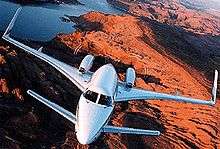
From the early to late 20th century, aircraft pioneers such as Clyde Cessna, "Matty" Laird, Lloyd Stearman, Walter Beech, Al Mooney and Bill Lear began aircraft-manufacturing enterprises that would lead to Wichita becoming the nation's leading city in numbers of aircraft produced. The aircraft corporations E. M. Laird Aviation Company (the nation's first successful commercial airplane manufacturer), Travel Air (started by Beech, Stearman and Cessna), Stearman, Cessna, Beechcraft and Mooney were all founded in Wichita between 1920 and early 1932.[14] By 1931, Boeing (of Seattle, Washington) had absorbed Stearman, creating "Boeing-Wichita", which would eventually grow to become Kansas' largest employer.[15][103]
Today, Cessna Aircraft Co. (the world's highest-volume airplane manufacturer) and Beechcraft remain based in Wichita having merged into Textron Aviation in 2014, along with Learjet and Boeing's chief subassembly supplier, Spirit AeroSystems. Airbus maintains a workforce in Wichita, and Bombardier (parent company of Learjet) has other divisions in Wichita as well. Over 50 other aviation businesses operate in the Wichita MSA, as well dozens of suppliers and subcontractors to the local aircraft manufacturers. In total, Wichita and its companies have manufactured an estimated 250,000 aircraft since Clyde Cessna's first Wichita-built aircraft in 1916.[15][16][104][105]
In the early 2000s, a national and international recession combined with the after effects of the September 11, 2001 terrorist attacks to depress the aviation sub-sector in and around Wichita. Orders for new aircraft plummeted, prompting Wichita's five largest aircraft manufacturers, Boeing Co., Cessna Aircraft Co., Bombardier Learjet Inc., Hawker Beechcraft and Raytheon Aircraft Co.—to slash a combined 15,000 jobs between 2001 and 2004. In response, these companies began developing small- and mid-sized airplanes to appeal to business and corporate users.[91] In 2007, Wichita built 977 aircraft, ranging from single-engine light aircraft to the world's fastest civilian jet; one-fifth of the civilian aircraft produced in United States that year, plus numerous small military aircraft.[16][104][105][106] In early 2012, Boeing announced it would be closing its Wichita plant by the end of 2013,[107] which paved the road for Spirit Aerosystems to open its plant.
Culture
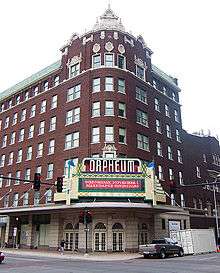
Wichita has a complex cultural mix, dominated by Euro-American, blue-collar industrial and rural tastes, but embracing, to various degrees, classical arts and music, diverse domestic and foreign cultures (Hispanic, African-American, Native American, Asian, British and Irish cultural influences and activities are conspicuous), and avant garde cultural activity.
Arts
Wichita is a cultural center for Kansas, home to several art museums and performing arts groups. The Wichita Art Museum is the largest art museum in the state of Kansas and contains 7,000 works in permanent collections.[108] The Ulrich Museum of Art at Wichita State University is a modern and contemporary art museum with over 6,300 works in its permanent collection.[109]
Small art galleries are scattered around the city with some clustered in the districts of Old Town, Delano and south Commerce street. These galleries started the Final Friday Gallery crawl event, where visitors tour attractions free in the evening on the last Friday of each month. Larger museums began participating and staying open late on Final Fridays shortly after its beginning.
Music
Wichita is the music hub of central Kansas, and draws major acts from around the world, performing at various concert halls, arenas and stadiums around the area. Most major rock'n'roll and pop-music stars, and virtually all country music stars, perform there during their career.
Music Theatre Wichita, Wichita Grand Opera (both nationally renowned),[110] and the Wichita Symphony Orchestra perform regularly at the Century II Convention Hall downtown. Concerts are also regularly performed by the nationally noted schools of music at Wichita's two largest universities.[110][111]
The Orpheum Theatre, a classic movie palace built in 1922, serves as a downtown venue for smaller shows.
Wichita is alleged to be the birthplace of the electric guitar, the fuzz box, and other key innovations in rock'n'roll music.
Events
The Wichita River Festival has been held in the Downtown and Old Town areas of the city since 1972. It has featured events, musical entertainment, sporting events, traveling exhibits, cultural and historical activities, plays, interactive children's events, a flea market, river events, a parade, block parties, a food court, fireworks, and souvenirs for the roughly 370,000+ patrons who attend each year.[112] In 2011, the festival was moved from May to June because of rain during previous festivals. The Wichita River Festival has seen immense growth, with record numbers in 2016 and again in 2018.[113] Much of that growth is attributed to attractive musical acts at the festival.[114]
The annual Wichita Black Arts Festival, held in the spring, celebrates the arts, crafts and creativity of Wichita's large African-American community. It usually takes place in Central-Northeast Wichita. A Juneteenth event and parade also are common annual events.
The International Student Association at Wichita State University presents an annual international cultural exhibition and food festival, on the campus at WSU, providing an inexpensive sampling of global culture and cuisine to the general public.
One or more large Renaissance fairs occur annually, including the "RenFair" in conjunction with the "Kingdom of Calontir" of the SCA (Society for Creative Anachronism). The fairs vary in length from one day to a week, typically at Sedgwick County Park or Newman University.
The Wichita Public Library's Academy Awards Shorts program is reportedly the oldest annual, complete, free public screening outside of Hollywood of the full array of short films nominated for an Academy Award ("Oscar"). In late winter, shortly before the Academy Awards ceremonies, the films—including all nominated documentary, live action, and animated shorts—are presented, free, at the Library and in local theaters and other venues around Wichita. Wichita's former Congressman, Motion Picture Association President Dan Glickman, has served as Honorary Chair of the event, and some of the filmmakers have attended and visited with the audiences.[115][116][117][118][119][120]
The Tallgrass Film Festival has been held in downtown Wichita since 2003. It draws over 100 independent feature and short films from all over the world for three days each October. Notable people from the entertainment industry have attended the festival.[121]
Aviation-related events are common in the Wichita area, including air shows, fly-ins, air races, aviation conferences, exhibitions, and trade shows. The city's two main air shows, which are generally held in alternating years, are the city-sponsored civilian Wichita Flight Festival[122] (originally the "Kansas Flight Festival") and the military-sponsored McConnell Air Force Base Open House and Airshow.[123] Both are large regional air shows with famous acts and multimillion-dollar aircraft displays (including many Wichita-built aircraft). In addition, numerous local, regional, and national aviation organizations host fly-ins, conferences, exhibitions and trade shows in the Wichita area on irregular schedules.
Points of interest
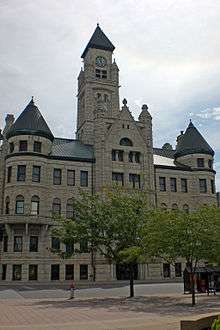
Museums and landmarks devoted to science, culture, and area history are located throughout the city. Several lie along the Arkansas River west of downtown, including the Exploration Place science and discovery center, the Mid-America All-Indian Center, the Old Cowtown living history museum, and The Keeper of the Plains statue and its associated display highlighting the daily lives of Plains Indians. The Wichita-Sedgwick County Historical Museum in downtown Wichita occupies the original Wichita city hall, built in 1892. The museum contains artifacts that tell the story of Wichita and Sedgwick County starting from 1865 and continuing to the present day.[124] Nearby is the 1913 Sedgwick County Memorial Hall and Soldiers and Sailors Monument. East of downtown are the Museum of World Treasures and railroad-oriented Great Plains Transportation Museum. The Coleman Factory Outlet and Museum was at 235 N St. Francis street and was the home of the Coleman Lantern until it closed in 2018.[125] Wichita State University hosts the Lowell D. Holmes Museum of Anthropology. The Kansas Aviation Museum, housed in the Terminal and Administration building of the former Municipal Airport, is in southeast Wichita adjacent to McConnell Air Force Base.
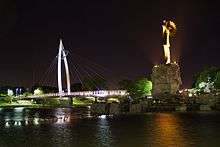
Botanica, The Wichita Gardens, also along the Arkansas River, has 24 themed gardens including the Butterfly Garden and the award-winning Sally Stone Sensory Garden. The Sedgwick County Zoo in the northwest part of Wichita is the most popular outdoor tourist attraction in the state of Kansas, and is home to more than 2,500 animals representing 500 different species.[126] The zoo is next to Sedgwick county park and Sedgwick County Extension Arboretum.
Intrust Bank Arena is the city's primary event venue, featuring 22 suites, 2 party suites, 40 loge boxes and over 300 premium seats with a total potential capacity of over 15,000.[127] This arena in the middle of Wichita opened in January 2010.[128]
Located immediately east of downtown is Old Town, the city's entertainment district. In the early 1990s, developers transformed it from an old warehouse district into a mixed-zone neighborhood with residential space, nightclubs, restaurants, hotels, and museums.[129]
Moody's Skidrow Beanery, at 625 E. Douglas in what was to become Old Town, was one of the more famous places in Wichita in the 1960s. It was the scene of a nationally followed First Amendment struggle[130] and was visited by Allen Ginsberg in 1966 (the name had been changed to the Magic Theatre Vortex Art Gallery) where he first read his long poem "Wichita Vortex Sutra."
Wichita is also home to one major indoor shopping mall: Towne East Square, managed by Simon Property Group. Towne East is home to four anchor stores, and has more than 100 tenants. A second large indoor shopping mall, Towne West Square, has seen all major and many smaller tenants leave and was put into foreclosure in 2019.[131] The oldest mall, Wichita Mall, was for many years largely a dead mall, but has since been converted into office space.[132] There are also two large outdoor shopping centers, Bradley Fair on the city's north-east side and NewMarket Square on the city's north-west side, each with over 50 stores spread out on several acres.
In 1936, the Wichita post office contained two oil-on-canvas murals, Kansas Farming, painted by Richard Haines and Pioneer in Kansas by Ward Lockwood. Murals were produced from 1934 to 1943 in the United States through the Section of Painting and Sculpture, later called the Section of Fine Arts, of the Treasury Department. The post office building became the Federal Courthouse at 401 N. Market Street and the murals are on display in the lobby.[133]
Wichita also has a number of parks and recreational areas such as Riverside park, College Hill park, and McAdams Park.
In popular culture and the arts
Wichita is mentioned in the songs "Wichita Skyline" by Shawn Colvin, "Seven Nation Army" by The White Stripes, and "Captain Bobby Stout" by local musician Jerry Hahn. Allen Ginsberg wrote about a visit to Wichita in his poem Wichita Vortex Sutra, for which Philip Glass subsequently wrote a solo piano piece. Glen Campbell's "Wichita Lineman", written by Jimmy Webb, peaked at number 1 on Billboard's country singles chart and at number 3 on the pop chart in 1968. Ruby Vroom, released by the band Soul Coughing in 1994, contains a song called "True Dreams of Wichita". Also, country trio Lady Antebellum recorded the song "Golden" for their fifth studio album of the same name. The opening line of that song is "Sunset falls on Wichita". In 1976 Charlie Daniels released the country song "Wichita Jail" and actor John Corbett released his country song Wichita.
The city has been a setting of various works of fiction. The award-winning stage play Hospitality Suite written by Roger Rueff takes place in Wichita as does its 1999 film adaptation, The Big Kahuna.[134] Wichita (1955) and portions of Wyatt Earp (1994), both of which dramatize the life and career of Wyatt Earp, are set in Wichita.[135][136] The short-lived 1959–1960 television western Wichita Town was set during the city's early years.[137] Other films wholly or partially set in the city include Good Luck, Miss Wyckoff (1979),[138] Planes, Trains and Automobiles (1987),[139] The Ice Harvest (2005),[140] and Knight and Day (2010).[141] The city is also the setting of the long-running comic strip Dennis the Menace.[142] The city in post-apocalyptic form is also the setting of majority of the book trilogy, The Testing by Joelle Charbonneau.
AMD planned to release a new processor, code named Wichita, in 2012, but the project was cancelled in favor of a newer design.
Sports

Wichita is home to several professional, semi-professional, non-professional, and collegiate sports teams. Professional teams include the Wichita Thunder ice hockey team and Wichita Force indoor football team. In 2020, the New Orleans Baby Cakes, a Minor League Baseball team of the Triple-A Pacific Coast League relocated to the city and will play at Riverfront Stadium on the site of the former Lawrence–Dumont Stadium; the team will play as the Wichita Wind Surge.[143] The city hosts the Air Capital Classic, a professional golf tournament of the Web.com Tour first played in 1990.
Defunct professional teams which used to play in Wichita include the Wichita Aeros and Wichita Wranglers baseball teams, the Wichita Wings indoor soccer team, the Wichita Wind (farm team to the Edmonton Oilers National Hockey League team in the early 1980s) and the Wichita Wild indoor football team. Semi-pro teams included the Kansas Cougars and Kansas Diamondbacks football teams.[144][145] Non-professional teams included the Wichita Barbarians rugby union team and the Wichita World 11 cricket team.[146][147]
Collegiate teams based in the city include the Wichita State University Shockers, Newman University Jets, and the Friends University Falcons. The WSU Shockers are NCAA Division I teams which compete in men's and women's basketball, baseball, volleyball, track and field, tennis, and bowling. The Newman Jets are NCAA Division II teams which compete in baseball, basketball, bowling, cross country, golf, soccer, tennis, wrestling, volleyball, and cheer/dance. The Friends Falcons compete in Region IV of the NAIA in football, volleyball, soccer, cross country, basketball, tennis, track and field, and golf.
Several sports venues are in and around the city. Intrust Bank Arena, downtown, is a 15,000-seat multi-purpose arena that is home to the Wichita Thunder. Lawrence–Dumont Stadium, just west of downtown, was a medium-sized baseball stadium that has been home to Wichita's various minor-league baseball teams over the years. It was also home of the minor-league National Baseball Congress and the site of the Congress's annual National Tournament.
Wichita Ice Arena, also just west of downtown, is a public ice-skating rink used for ice-skating competitions. In addition, Century II has been used for professional wrestling tournaments, sporting-goods exhibitions, and other recreational activity. The WSU campus includes two major venues: Eck Stadium, a medium-sized stadium with a full-sized baseball field that is home to the WSU Shocker baseball team, and Charles Koch Arena, a medium-sized, dome-roofed circular arena with a collegiate basketball court that hosts the WSU Shocker basketball team. Koch Arena is also used extensively for citywide and regional high school athletic events, concerts and other entertainments. Just north of the city is 81 Motor Speedway, an oval motor-vehicle racetrack used extensively for a wide range of car, truck and motorcycle races, and other motor sports events. Neighboring Park City is home to Hartman Arena and the Sam Fulco Pavilions, a moderate-capacity low-roofed arena developed for small rodeos, horse shows, livestock competitions, and exhibitions.
Wichita is also home to two sports museums, the Kansas Sports Hall of Fame and the Wichita Sports Hall of Fame and Museum.[148][149]
Professional
| Team | League | Sport |
|---|---|---|
| Wichita Thunder | ECHL | Ice hockey |
| Wichita Force | CIF | Indoor football |
| Wichita Wind Surge* | PCL | Baseball |
College
| School | School Nickname | Level | # of Teams |
|---|---|---|---|
| Wichita State University | Shockers | NCAA Division I | 15 |
| Newman University | Jets | NCAA Division II | 16 |
| Friends University | Falcons | NAIA | 15 |
*The Miami Marlins Triple-A affiliate, the New Orleans Baby Cakes, will relocate to Wichita and become the Wind Surge in 2020.[150]
Government
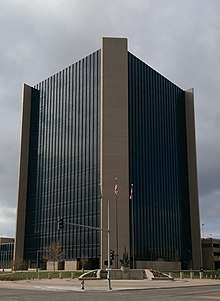
Under state statute, Wichita is a city of the first class.[151] Since 1917, it has had a council–manager form of government.[152] The city council consists of seven members popularly elected every four years with staggered terms in office. For representative purposes, the city is divided into six districts with one council member elected from each. The mayor is the seventh council member, elected at large. The council sets policy for the city, enacts laws and ordinances, levies taxes, approves the city budget, and appoints members to citizen commission and advisory boards.[153] It meets each Tuesday.[151] The city manager is the city's chief executive, responsible for administering city operations and personnel, submitting the annual city budget, advising the city council, preparing the council's agenda, and oversight of non-departmental activities.[152] As of 2020, the city council consists of: Mayor Brandon Whipple, Brandon Johnson (District 1), Becky Tuttle (District 2), James Clendenin (District 3), Jeff Blubaugh (District 4), Bryan Frye (District 5), and Cindy Claycomb (District 6).[154] The city manager is Robert Layton.[155]
The Wichita Police Department, established in 1871, is the city's law enforcement agency.[156] With over 800 employees, including more than 600 commissioned officers, it is the largest law enforcement agency in Kansas.[157] The Wichita Fire Department, organized in 1886, operates 22 stations throughout the city. Organized into four battalions, it employs over 400 full-time firefighters.[158]
As the county seat, Wichita is the administrative center of Sedgwick County. The county courthouse is downtown, and most departments of the county government base their operations in the city.[159]
Many departments and agencies of the U.S. Government have facilities in Wichita. The Wichita U.S. Courthouse, also downtown, is one of the three courthouses of the U.S. District Court for the District of Kansas.[160] The U.S. Air Force operates McConnell Air Force Base immediately southeast of the city.[161] The campus of the Robert J. Dole Department of Veterans Affairs Medical and Regional Office Center is on U.S. 54 in east Wichita.[162] Other agencies, including the Federal Bureau of Investigation,[163] Food and Drug Administration,[164] and Internal Revenue Service[165] among others, have offices around the city.
Wichita lies within Kansas's 4th U.S. Congressional District. For the purposes of representation in the Kansas Legislature, the city is in the 16th and 25th through 32nd districts of the Kansas Senate and the 81st, 83rd through 101st, 103rd, and 105th districts of the Kansas House of Representatives.[151]
Education

Primary and secondary education
With over 50,000 students, Wichita USD 259 is the largest school district in Kansas.[166] It operates more than 90 schools in the city including 10 high schools, 16 middle schools, 61 elementary schools, and more than a dozen special schools and programs.[167] Outlying portions of Wichita lie within suburban public unified school districts including Andover USD 385, Circle USD 375, Derby USD 260, Goddard USD 265, Haysville USD 261, Maize USD 266, and Valley Center USD 262.[168]
There are more than 35 private and parochial schools in Wichita.[169] The Roman Catholic Diocese of Wichita oversees 16 Catholic schools in the city including 14 elementary schools and two high schools, Bishop Carroll Catholic High School and Kapaun Mt. Carmel High School.[170] The Lutheran Church–Missouri Synod operates two Lutheran schools in the city, Bethany Lutheran School (Grades PK-5) and Holy Cross Lutheran School (PK-8).[171][172] There are also two Seventh-day Adventist schools in Wichita, Three Angels School (K-8) and Wichita Adventist Christian Academy (K-10).[173][174] Other Christian schools in the city are Calvary Christian School (PK-12), Central Christian Academy (K-10), Classical School of Wichita (K-12), Sunrise Christian Academy (PK-12), Trinity Academy (9-12), Wichita Friends School (PK-6), and Word of Life Traditional School (K-12). In addition, there is an Islamic school, Anoor School (PK-8), operated by the Islamic Society of Wichita. Non-religious private schools in the city include Wichita Collegiate School and The Independent School as well as three Montessori schools.[175]
Colleges and universities
Three universities have their main campuses in Wichita. The largest is Wichita State University (WSU), a public research university classified by Carnegie as "R2: Doctoral Universities – Higher Research Activity." WSU has more than 14,000 students and is the third-largest university in Kansas.[176][177] WSU's main campus is in northeast Wichita with multiple satellite campuses around the metro area.[178] Friends University, a private, non-denominational Christian university, has its main campus in west Wichita as does Newman University, a private Catholic university.[179][180]
Several colleges and universities based outside Wichita operate satellite locations in and around the city. The University of Kansas School of Medicine has one of its three campuses in Wichita.[181] Baker University, Butler Community College, Embry-Riddle Aeronautical University, Southwestern College, Tabor College, Vatterott College, and Webster University have Wichita facilities as do for-profit institutions including Heritage College and University of Phoenix.[182][183][184][185]
Libraries
The Wichita Public Library is the city's library system, presently consisting of a central facility, the Advanced Learning Library in Delano and six branch locations in other neighborhoods around the city.[186] The library operates several free programs for the public, including special events, technology training classes, and programs specifically for adults, children, and families.[187] As of 2009, its holdings included more than 1.3 million books and 2.2 million items total.[188]
Media
The Wichita Eagle, which began publication in 1872, is the city's major daily newspaper.[189] Colloquially known as The Eagle, it was created from the 1960s merger of the city's two principal newspapers: The Wichita Eagle and The Wichita Beacon. The Wichita Business Journal is a weekly newspaper that covers local business events and developments.[190] Several other newspapers and magazines, including local lifestyle, neighborhood, and demographically focused publications are also published in the city.[191] These include: The Community Voice, a weekly African American community newspaper;[192] El Perico, a monthly Hispanic community newspaper;[193][194] The Liberty Press, monthly LGBT news;[195] Splurge!, a monthly local fashion and lifestyle magazine;[196] The Sunflower, the Wichita State University student newspaper.[197] The Wichita media market also includes local newspapers in several surrounding suburban communities.
The Wichita radio market includes Sedgwick County and neighboring Butler and Harvey counties.[198] Six AM and more than a dozen FM radio stations are licensed to and/or broadcast from the city.[199]
Wichita is the principal city of the Wichita-Hutchinson, Kansas television market, which comprises the western two-thirds of the state.[200] All of the market's network affiliates broadcast from Wichita with the ABC, CBS, CW, FOX and NBC affiliates serving the wider market through state networks of satellite and translator stations.[201][202][203][204][205][206] The city also hosts a PBS member station, a Univision affiliate, and several low-power stations.[207][208]
Wichita also utilizes local online news and event sites such as 360Wichita.com which has operated in Wichita since 1999.
Infrastructure
Flood control
Wichita suffered severe floods of the Arkansas river in 1877, 1904, 1916, 1923, 1944, 1951 and 1955. In 1944 the city flooded 3 times in 11 days.[209] As a result of the 1944 flood, the idea for the Wichita-Valley Center Floodway (locally known as the "Big Ditch") was conceived. The project was completed in 1958. The Big Ditch diverts part of the Arkansas River's flow around west-central Wichita, running roughly parallel to the Interstate 235 bypass.[59][210] A second flood control canal lies between the lanes of Interstate 135, running south through the central part of the city. Chisholm Creek is diverted into this canal for most of its length.[59][211] The city's flood defenses were tested in the Great Flood of 1993. Flooding that year kept the Big Ditch full for more than a month and caused $6 million of damage to the flood control infrastructure. The damage was not fully repaired until 2007.[212] In 2019, the Floodway was renamed the MS Mitch Mitchell Floodway in honor of the man credited for its creation.[213]
Utilities
Westar Energy provides electric power.[214] Cox Communications and Spectrum offer cable television, and AT&T U-Verse offers IPTV.[215] All three also offer home telephone and broadband internet service.[216] Kansas Gas Service provides utility natural gas.[217] The City of Wichita's department of Public Works and Utilities manages water provision and distribution, waste water treatment, and storm water drainage.[218] Multiple privately owned trash haulers, licensed by the county government, offer trash removal and recycling service.[219]
Health care
Via Christi Health operates three general medical and surgical hospitals in Wichita—Via Christi Hospital St. Francis, Via Christi Hospital St. Joseph, and Via Christi Hospital St. Teresa—and other specialized medical facilities.[220] The Hospital Corporation of America manages a fourth general hospital, Wesley Medical Center, along with satellite locations around the city.[221] All four hospitals provide emergency services. In addition, the U.S. Department of Veterans Affairs runs the Robert J. Dole VA Medical Center, a primary and secondary care facility for U.S. military veterans.[162]
Transportation
Highway
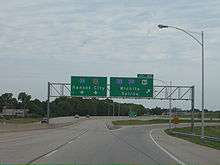
The average commute time in Wichita was 18.2 minutes from 2013 to 2017.[222] Several federal and state highways pass through the city. Interstate 35, as the Kansas Turnpike, enters the city from the south and turns northeast, running along the city's southeastern edge and exiting through the eastern part of the city. Interstate 135 runs generally north-south through the city, its southern terminus lying at its interchange with I-35 in south-central Wichita. Interstate 235, a bypass route, passes through north-central, west, and south-central Wichita, traveling around the central parts of the city. Both its northern and southern termini are interchanges with I-135. U.S. Route 54 and U.S. Route 400 run concurrently through Wichita as Kellogg Avenue, the city's primary east-west artery, with interchanges, from west to east, with I-235, I-135, and I-35. U.S. Route 81, a north-south route, enters Wichita from the south as Broadway, turns east as 47th Street South for approximately half a mile, and then runs concurrently north with I-135 through the rest of the city. K-96, an east-west route, enters the city from the northwest, runs concurrently with I-235 through north-central Wichita, turns south for approximately a mile, running concurrently with I-135 before splitting off to the east and traveling around northeast Wichita, ultimately terminating at an interchange with U.S. 54/U.S. 400 in the eastern part of the city. K-254 begins at I-235's interchange with I-135 in north-central Wichita and exits the city to the northeast. K-15, a north-south route, enters the city from the south and joins I-135 and U.S. 81 in south-central Wichita, running concurrently with them through the rest of the city. K-42 enters the city from the southwest and terminates at its interchange with U.S. 54/U.S. 400 in west-central Wichita.[59]
Bus
Wichita Transit operates 53 buses on 18 fixed bus routes within the city. The organization reports over 2 million trips per year (5,400 trips per day) on its fixed routes. Wichita Transit also operates a demand response paratransit service with 320,800 passenger trips annually.[223] A 2005 study ranked Wichita near the bottom of the fifty largest American cities in terms of percentage of commuters using public transit. Only 0.5% used it to get to or from work.[224]
Greyhound Lines provides intercity bus service northeast to Topeka and south to Oklahoma City, Oklahoma. Bus service is provided daily north towards Salina and west towards Pueblo, Colorado by BeeLine Express (subcontractor of Greyhound Lines).[225][226] The Greyhound bus station that was built in 1961 at 312 S Broadway closed in 2016, and services relocated 1 block northeast to the Wichita Transit station at 777 E Waterman.[227]
Air
The Wichita Airport Authority manages the city's two main public airports, Wichita Dwight D. Eisenhower National Airport and Colonel James Jabara Airport.[228] Located in the western part of the city, Wichita Dwight D. Eisenhower National Airport is the city's primary airport as well as the largest airport in Kansas.[59][228] Six commercial airlines (Alaska, Allegiant, American, Delta, Southwest & United) serve Wichita Dwight D. Eisenhower National Airport with non-stop flights to several U.S. airline hubs.[229] Jabara Airport is a general aviation facility on the city's northeast side.[230] The city also has several privately owned airports. Cessna Aircraft Field and Beech Factory Airport, operated by manufacturers Cessna and Beechcraft, respectively, lie in east Wichita.[231][232] Two smaller airports, Riverside Airport and Westport Airport, are in west Wichita.[233][234]
Rail
.jpg)
Two Class I railroads, BNSF Railway and Union Pacific Railroad (UP), operate freight rail lines through Wichita.[235] UP's OKT Line runs generally north-south through the city; north of downtown, the line consists of trackage leased to BNSF.[59][236] An additional UP line enters the city from the northeast and terminates downtown.[59] BNSF's main line through the city enters from the north, passes through downtown, and exits to the southeast, paralleling highway K-15.[59][237] The Wichita Terminal Association, a joint operation between BNSF and UP, provides switching service on three miles (5 km) of track downtown.[238] In addition, two lines of the Kansas and Oklahoma Railroad enter the city, one from the northwest and the other from the southwest, both terminating at their junction in west-central Wichita.[59]
Wichita has not had passenger rail service since 1979.[239] The nearest Amtrak station is in Newton 25 miles (40 km) north, offering service on the Southwest Chief line between Los Angeles and Chicago.[235] Amtrak offers bus service from downtown Wichita to its station in Newton as well as to its station in Oklahoma City, the northern terminus of the Heartland Flyer line.[240]
Walkability
A 2014 study by Walk Score ranked Wichita 41st most walkable of fifty largest U.S. cities.[241]
Cycling
After numerous citizen surveys showed Wichitans want better bicycle infrastructure, The Wichita Bicycle Master Plan, a set of guidelines toward the development of a 149-mile Priority Bicycle Network, was endorsed by the Wichita City Council on February 5, 2013 as a guide to future infrastructure planning and development. As a result, Wichita's bikeways covered 115 miles of the city by 2018. One third of the bikeways were added between 2011, when the plan was still in development, and 2018.[242][243]
The League of American Bicyclists added Wichita as one of 462 bicycle friendly communities to its Fall, 2017 list of Bicycle Friendly Communities, awarding it a bronze award.[244]
Notable people
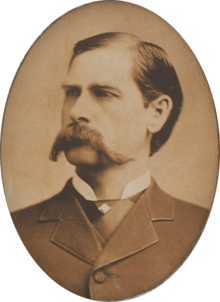
Historical
Wyatt Earp served as a lawman in several old west frontier towns, including Wichita. Other old west figures lived in Wichita for a while: James Earp, Cassius M. Hollister, Bat Masterson, Ed Masterson, James Masterson.
Politics
Numerous politicians and government employees were born, raised, lived in Wichita. Mike Pompeo, U.S. Secretary of State, and former Director of the U.S. Central Intelligence Agency, began his political career in the Wichita area as 4th district Congressman. Robert Gates, former U.S. Secretary of Defense, and former Director of the U.S. Central Intelligence Agency, is a Wichita native and graduate of Wichita schools.[245] Dan Glickman, former Secretary of Agriculture, began his political career in Wichita, first on the local school board, then as 4th district Congressman.[246]
Business
Koch family, specifically Charles and David Koch (Koch Industries), prominent billionaires, political activists, philanthropists, were born and raised in Wichita. Additionally, Dan and Frank Carney (Pizza Hut), Clyde Cessna (Cessna Aircraft), Walter Beech and Olive Ann Beech (Beech Aircraft), Bill Lear (Lear Jet), Lloyd Stearman (Stearman Aircraft), William Coleman (Coleman Company), billioinaire Phil Ruffin (Treasure Island Hotel and Casino) all were raised or lived in Wichita.
Athletes
Athletes including Pro Football Hall of Fame running backs Gale Sayers and Barry Sanders,[245] Basketball Hall of Famer Lynette Woodard, and UFC flyweight fighter Tim Elliott were all born and/or raised in Wichita. Summer Olympic medal winning athletes Jim Ryun and Nico Hernandez are both from Wichita.
Media
Actress Kirstie Alley, known for her role in the TV show Cheers, who was born and raised in Wichita and lives in the city part-time.[245] Actor Don Johnson, lead actor in the TV series Miami Vice and Nash Bridges, lived in Wichita for most of his childhood.[245] Musician Joe Walsh, founding member of the band James Gang and later member of The Eagles, is from Wichita. Actress Hattie McDaniel born in Wichita is best known for her role as "Mammy" in Gone with the Wind movie, for which she won the Academy Award for Best Supporting Actress, the first Oscar won by a black entertainer. Jim Lehrer was an journalist, novelist, and news anchor for PBS NewsHour.
Sister cities
Gallery
- Campbell Castle in Wichita's Riverside neighborhood (2013)
 Century II Performing Arts & Convention Center (2013)
Century II Performing Arts & Convention Center (2013) The Commerce Street Arts District in downtown Wichita (2008)
The Commerce Street Arts District in downtown Wichita (2008)- Charles Koch Arena at Wichita State University, is home to the Wichita State Shockers (2010)
- Davis Building at Friends University (2006)
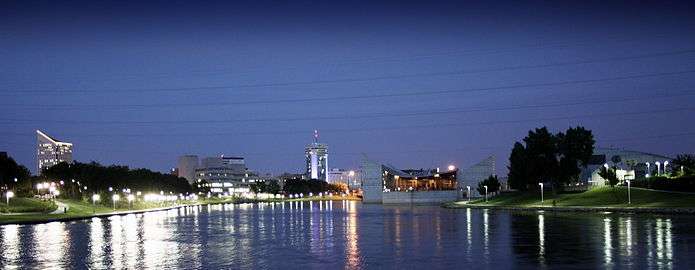 Downtown Wichita at night (2007)
Downtown Wichita at night (2007)- Eck Stadium at Wichita State University (2005)
.jpg) Edwin A. Ulrich Museum of Art at Wichita State University (2007)
Edwin A. Ulrich Museum of Art at Wichita State University (2007)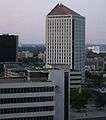 The Epic Center, the tallest building in Wichita (2006)
The Epic Center, the tallest building in Wichita (2006)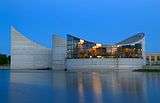 Exploration Place science museum (2013)
Exploration Place science museum (2013) Locomotives on display at the Great Plains Transportation Museum (2007)
Locomotives on display at the Great Plains Transportation Museum (2007) Intrust Bank Arena (2013)
Intrust Bank Arena (2013)- The John Mack Bridge over the Arkansas River in south Wichita (2013)
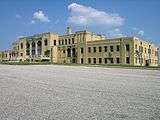 Kansas Aviation Museum, formerly Wichita Municipal Airport from 1935 to 1951 (2007)
Kansas Aviation Museum, formerly Wichita Municipal Airport from 1935 to 1951 (2007) Lawrence-Dumont Stadium (2014)
Lawrence-Dumont Stadium (2014)- The Robert J. Dole Veterans Affairs Medical Center (2013)
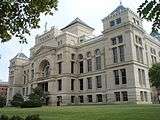 Old Sedgwick County Courthouse (2009)
Old Sedgwick County Courthouse (2009)- The Sedgwick County Soldiers and Sailors Monument (2013)
- The Downing Gorilla Forest at the Sedgwick County Zoo (2013)
 Wichita Art Museum (2012)
Wichita Art Museum (2012)
See also
- Abilene Trail
- Arkansas Valley Interurban Railway
- Joyland Amusement Park
- Wichita Public Schools
- McConnell Air Force Base
Notes
- Mean monthly maxima and minima (i.e. the expected highest and lowest temperature readings at any point during the year or given month) calculated based on data at said location from 1981 to 2010.
- Official records for Wichita have been kept at various locations in and around the city from July 1888 to November 1953 and at the Mid-Continent Airport since December 1953. For more information, see Threadex
References
- Harris, Richard (2002). "The Air Capital Story: Early General Aviation & Its Manufacturers". In Flight USA.
- "Travel Translator: Your guide to the local language in Wichita". VisitWichita.com.
- Geographic Names Information System (GNIS) details for Wichita, Kansas; United States Geological Survey (USGS); October 13, 1978.
- "US Gazetteer files 2010". United States Census Bureau. Archived from the original on July 2, 2012. Retrieved July 6, 2012.
- "U.S. Census website". United States Census Bureau. Retrieved December 7, 2017.
- "Population and Housing Unit Estimates". Retrieved May 28, 2019.
- United States Postal Service (2012). "USPS - Look Up a ZIP Code". Retrieved February 15, 2012.
- Wichita. CollinsDictionary.com. Collins English Dictionary - Complete & Unabridged 11th Edition. Retrieved October 21, 2012.
- "Kansas: 2000 Population and Housing Unit Counts" (PDF). United States Census Bureau. July 2003. p. 46. Retrieved January 20, 2011.
- "Population Estimates". United States Census Bureau. Retrieved May 28, 2019.
- "Metropolitan and Micropolitan Statistical Areas". Population Estimates. United States Census Bureau. Retrieved May 28, 2019.
- Miner, Prof. Craig (Wichita State Univ. Dept. of History), Wichita: The Magic City, Wichita Historical Museum Association, Wichita, KS, 1988
- Howell, Angela and Peg Vines, The Insider's Guide to Wichita, Wichita Eagle & Beacon Publishing, Wichita, KS, 1995
- McCoy, Daniel (interview with Beechcraft CEO Bill Boisture), "Back to Beechcraft," Wichita Business Journal, February 22, 2013
- Harris, Richard, "The Air Capital Story: Early General Aviation & Its Manufacturers", reprinted from In Flight USA magazine on author's own website, 2002/2003
- Harris, Richard, (Chairman, Kansas Aviation Centennial; Kansas Aviation History Speaker, Kansas Humanities Council; Amer. Av. Historical Soc.), "Kansas Aviation History: The Long Story" Archived August 8, 2017, at the Wayback Machine, 2011, Kansas Aviation Centennial website Archived December 29, 2018, at the Wayback Machine
- "Grove Park Archaeological Site". Historic Preservation Alliance of Wichita and Sedgwick County. Retrieved March 21, 2015.
- Brooks, Robert L. "Wichitas". Encyclopedia of the Great Plains. University of Nebraska–Lincoln. Retrieved March 21, 2014.
- Sturtevant, William C. (1967). "Early Indian Tribes, Culture Areas, and Linguistic Stocks [Map]". Smithsonian Institution. Retrieved March 21, 2015.
- "Louisiana Purchase". Kansapedia. Kansas Historical Society. Retrieved March 21, 2015.
- "Kansas Territory". Kansapedia. Kansas Historical Society. Retrieved March 21, 2015.
- "Days of Darkness: 1820-1934". Wichita and Affiliated Tribes. Retrieved April 30, 2019.
- Sowers, Fred A. (1910). "Early History of Wichita". History of Wichita and Sedgwick County, Kansas. Chicago: C.F. Cooper & Co. Retrieved March 21, 2015.
- Elam, Earl H. (June 15, 2010). "Wichita Indians". Handbook of Texas (online ed.). Texas State Historical Association.
- Howell, Angela; Vines, Peg (1995). The Insider's Guide to Wichita. Wichita, Kansas: Wichita Eagle & Beacon Publishing.
- "History of Wichita". Wichita Metro Chamber of Commerce. Archived from the original on March 16, 2015. Retrieved March 21, 2015.
- "Midtown Neighborhood Plan" (PDF). Wichita-Sedgwick County Metropolitan Area Planning Department. 2004. Archived from the original (PDF) on February 5, 2016. Retrieved March 21, 2015.
- Miner, Craig (1988). Wichita: The Magic City. Wichita, Kansas: Wichita Historical Museum Association.
- "Oldtown History". OldtownWichita.com. Archived from the original on January 19, 2009. Retrieved March 21, 2015.
- "Delano's Colorful History". Historic Delano, Inc. Retrieved March 21, 2015.
- "History of Wichita State University". Wichita State University. Retrieved March 26, 2015.
- "History". Friends University. Retrieved March 26, 2015.
- "Census of Population and Housing". United States Census Bureau. Retrieved March 26, 2015.
- "Overview". Delano Neighborhood Plan. City of Wichita, Kansas. Archived from the original on August 6, 2013. Retrieved March 26, 2015.
- Price, Jay M. (2005). El Dorado : legacy of an oil boom. Charleston, SC: Arcadia. ISBN 978-0738539713.
- "Petroleum Refining: A 125 Year Kansas Legacy" (PDF). Kansas Department of Health and Environment. Retrieved March 19, 2015.
- Dilsaver, Dick (November 18, 1967). "Fred Koch, Industrialist, Dies in Utah". The Wichita Beacon. Missing or empty
|url=(help) - "Aeronautical Yearbook, 1929". Aeronautical Chamber of Commerce. Missing or empty
|url=(help) - Tanner, Beccy (January 5, 2012). "Boeing's Wichita history dates to 1927". The Wichita Eagle. Retrieved March 26, 2015.
- "History of the Building". Kansas Aviation Museum. Retrieved March 26, 2015.
- Herman, Arthur. Freedom's Forge: How American Business Produced Victory in World War II, pp. 297-300, 307-8, 314-318, 321, Random House, New York, NY, 2012. ISBN 978-1-4000-6964-4.
- "Learjet: A Brief History" (PDF). Bombardier Inc. January 2008. Retrieved March 26, 2015.
- "Wichita, Kansas". Encyclopedia of the Great Plains. University of Nebraska–Lincoln. Retrieved March 28, 2015.
- "About Us". Mentholatum. Retrieved March 28, 2015.
- "First Light (1900-1929)". Coleman Company. Retrieved March 28, 2015.
- "Bronze Sculpture of Lunch Counter for Downtown Park is Tribute to Civil Rights Activists". The Wichita Eagle. February 4, 1998. Retrieved March 28, 2015.
- Wilkerson, Isabel (August 4, 1991). "Drive Against Abortion Finds a Symbol: Wichita". The New York Times. Retrieved March 28, 2015.
- Davey, Monica; Stumpe, Joe (May 31, 2009). "Abortion Doctor Shot to Death in Kansas Church". The New York Times. Retrieved March 28, 2015.
- "Wichita Downtown Development Corp". OldtownWichita.com. Retrieved March 28, 2015.
- Neil, Denise (December 6, 2014). "After 5 years, Intrust Bank Arena still battles image problem". The Wichita Eagle. Retrieved March 28, 2015.
- McMillin, Molly (July 29, 2014). "End of an era: Boeing in final stages of leaving Wichita". The Wichita Eagle. Retrieved March 28, 2015.
- "Airbus Americas". OldtownWichita.com. Archived from the original on April 2, 2015. Retrieved March 28, 2015.
- Siebenmark, Jerry. "Eisenhower's granddaughter helps Wichita rename its airport". The Wichita Eagle. Retrieved March 28, 2015.
- "2003-2004 Official Transportation Map" (PDF). Kansas Department of Transportation. 2003. Retrieved January 1, 2011.
- "City Distance Tool". Geobytes. Archived from the original on October 5, 2010. Retrieved January 1, 2011.
- "Ecoregions of Nebraska and Kansas" (PDF). Environmental Protection Agency. 2001. Retrieved January 1, 2011.
- "Arkansas River and Wellington-McPherson Lowlands - Introduction". Kansas Geological Survey. May 3, 2005. Archived from the original on June 7, 2011. Retrieved January 1, 2011.
- "Sedgwick County Geohydrology - Geography". Kansas Geological Survey. December 1965. Retrieved January 1, 2011.
- "City of Wichita" (PDF). Kansas Department of Transportation. June 2010. Retrieved January 1, 2011.
- "General Highway Map - Sedgwick County, Kansas" (PDF). Kansas Department of Transportation. June 2009. Retrieved January 1, 2011.
- Peel, M. C.; Finlayson, B. L.; McMahon, T. A. (March 1, 2007). "Updated Köppen-Geiger climate classification map" (PDF). Hydrology and Earth System Sciences (4): 439–473. Retrieved January 25, 2012.
- "Kansas Tornado History - Historical Tornado Facts". Tornadochaser.com. Archived from the original on March 27, 2009. Retrieved September 12, 2009.
- "1991 Wichita-area tornado". Archived from the original on August 20, 2011. Retrieved April 21, 2011.
- "PHOTOS: 1965 Wichita tornado". Archived from the original on May 4, 2011. Retrieved April 21, 2011.
- "Historical Weather for Wichita, Kansas, United States of America". Weatherbase. Retrieved January 25, 2012.
- "Average weather for Wichita, KS". The Weather Channel. Retrieved January 25, 2012.
- "NOWData - NOAA Online Weather Data". National Weather Service Forecast Office - Wichita, KS. Retrieved September 6, 2018.
- "Station Name: KS WICHITA". National Oceanic and Atmospheric Administration. Retrieved March 10, 2013.
- "WMO Climate Normals for WICHITA/MID-CONTINENT ARPT KS 1961–1990". National Oceanic and Atmospheric Administration. Retrieved March 11, 2014.
- "Wichita, Kansas, USA - Monthly weather forecast and Climate data". Weather Atlas. Retrieved July 3, 2019.
- http://www.ait-themes.com, AitThemes.com. "Wichita Nightlife and Food - WichitaGov". www.wichitagov.org.
- "City of Wichita - Historic Preservation Main". Archived from the original on October 19, 2007. Retrieved October 30, 2007.
- Courtwright, Julie, Ph.D., Want to build a miracle city? : war housing in Wichita," winter 2000/2001, Kansas History: A Journal of the Central Plains, State Library of Kansas catalog # SS 1.19:v.23 no.4, downloaded from Kansas Historical Society, retrieved February 20, 2020
- A revitalization plan for the Hilltop Neighborhood: 60 years of community in southeast Wichita May, 2000, City of Wichita, retrieved February 20, 2020
- Geiszler-Jones, Amy, "Community Health," The Shocker, Wichita State University, as posted at University of Kansas retrieved February 20, 2020
- [https%3A%2F%2Fdigital.lib.ku.edu%2Fislandora%2Fobject%2Fku-phog%253A63131%2Fdatastream%2FOCR%2Fdownload&usg=AOvVaw01MsIj-14nU5xoLoO7K4I9 OCR extracts from various publications,] Google, retrieved February 20, 2020
- Tihen, Edward, "Plainview (sic), Planeview, Beechwood,", in Tihen Notes, Special Collections, Wichita State University, retrieved February 20, 2020
- United States Census Bureau. "Census of Population and Housing". Retrieved August 18, 2014.
- "Race and Ethnicity in the United States - Statistical Atlas". statisticalatlas.com.
- "U.S. Census website". United States Census Bureau. Retrieved November 12, 2011.
- "OMB Bulletin No. 10-02" (PDF). Office of Management and Budget. December 1, 2009. p. 59. Archived from the original (PDF) on March 16, 2012. Retrieved January 22, 2011.
- "OMB Bulletin No. 10-02" (PDF). Office of Management and Budget. December 1, 2009. p. 117. Archived from the original (PDF) on March 16, 2012. Retrieved January 22, 2011.
- Thomas, G. Scott (2011). "Metro Area Populations as of July 2011: 2011 - United States -- Metropolitan Statistical Area". 2011 American City Business Journals, Inc. American City Business Journals, Inc. Retrieved April 30, 2011.
- "Annual Estimates of the Population of Metropolitan and Micropolitan Statistical Areas: April 1, 2010 to July 1, 2013". 2013 Population Estimates. United States Census Bureau, Population Division. August 18, 2014. Archived from the original on June 27, 2014. Retrieved August 18, 2014.
- "Population and Housing Occupancy Status: 2010 - United States -- Combined Statistical Area". 2010 Census National Summary File of Redistricting Data. United States Census Bureau, Population Division. 2010. Archived from the original on February 12, 2020. Retrieved April 30, 2011.
- "Population and Housing Occupancy Status: 2010 - State -- County / County Equivalent". 2010 Census Redistricting Data (Public Law 94-171) Summary File. United States Census Bureau. Retrieved April 30, 2011.
- https://consumerist.com/2015/07/14/the-white-castle-story-the-birth-of-fast-food-the-burger-revolution/
- "Archived copy". Archived from the original on December 12, 2018. Retrieved December 29, 2018.CS1 maint: archived copy as title (link)
- www.bizjournals.com https://www.bizjournals.com/wichita/news/2019/08/12/slideshow-see-the-best-known-brands-in-kansas.html. Retrieved August 14, 2019. Missing or empty
|title=(help) - "Hawker Beechcraft secures $40 million incentive package to remain in Wichita". Retrieved January 2, 2011.
- "Wichita Chamber of Commerce". Wichitakansas.org. Retrieved July 15, 2013.
- "Hospital ready for visitors" Archived July 23, 2010, at the Wayback Machine, Wichita Eagle and Kansas.com, July 18, 2010.
- Tanner, Becky (September 1, 2016). "Wichita's Wesley Children's Hospital Officially Opens". The Wichita Eagle.
- "Forbes article". Forbes.
- "uipl_3002c2a3.html." United States Department of Labor. Retrieved on May 26, 2009.
- "Wichita, Kansas". City-Data.com. Retrieved March 11, 2015.
- "Best Places to Live 2006". Money Magazine. 2006. Archived from the original on August 5, 2008. Retrieved August 5, 2008.
- "2008 MSN Real Estate best bargain markets". MSN Real Estate. 2008. Archived from the original on January 15, 2008. Retrieved August 26, 2008.
- Greenberg, Peter. "Newsmax Magazine Rates the Top 25 Most Uniquely American Cities And Towns". Newsmax. Retrieved January 13, 2014.
- "Wichita, Kansas," U. S. News & World Report, retrieved December 28, 2019
- "Wichita, Kansas, Crime Rate & Safety" U. S. News & World Report, retrieved December 28, 2019
- "State Rankings on Overall Child Well-Being"2019 KIDS COUNT Data Book, Annie E. Casey Foundation, retrieved December 29, 2019
- Bissionette, Bruce, The Wichita 4: Cessna, Moellendick, Beech & Stearman (from interviews with Matty Laird, Lloyd Stearman, Olive Ann Beech, Dwayne Wallace, Rawdon, Burnham, and other principals), Aviation Heritage Books, Destin, FL, 1999.
- Rowe, Frank J. (aviation engineering executive) & Prof. Craig. Miner (Wichita State Univ. Dept. of History). Borne on the South Wind: A Century of Kansas Aviation, Wichita Eagle & Beacon Publishing Co., Wichita. 1994 (the standard reference work on Kansas aviation history)
- Penner, Marci, editor, and Richard Harris, contributor, in "Wichita Aviation Industry" in "8 Wonders of Kansas Commerce" on the Kansas Sampler website of the Kansas Sampler Foundation, sponsored by the Kansas Humanities Council for the Kansas 150 Sesquicentennial, 2010–2011.
- General Aviation Manufacturers Association (GAMA), GAMA Statistical Databook & Industry Outlook 2007, Washington, D.C.GAMA (General Aviation Manufacturers Association), GAMA Statistical Databook & Industry Outlook 2010 Archived July 22, 2011, at the Wayback Machine, Washington, D.C. (which includes historical data for previous 10 years)
- "Boeing to close Wichita Facility by end of 2013". Retrieved February 18, 2012.
- "Wichita Art Museum Visitor Information". Wichitaartmuseum.org. Retrieved September 12, 2009.
- "About Us". Ulrich Museum of Art at Wichita State University. Retrieved September 14, 2015.
- Who knew Wichita was such a talent pipeline to Broadway?" March 29, 2017, Wichita Eagle, retrieved April 3, 2017.
- Leiker, Amy Renee, "Opera singer Sam Ramey to coach vocal music at WSU," August 29, 2012, Wichita Eagle, retrieved April 3, 2017.
- "River Festival estimates record attendance". wichita.bizjournals.com.
- "Riverfest attendance and button sales up, arrests down". kansas. Retrieved June 12, 2018.
- "Riverfest slowly turning critics to fans with killer concert lineups". kansas. Retrieved June 12, 2018.
- "Wichita Public Library - Programs - 28th Annual Academy Awards Shorts Archived October 6, 2014, at the Wayback Machine, website of the Wichita Public Library, City of Wichita, Wichita, Kansas, 03/03/2014, downloaded 09/22/2014
- "26th Annual Academy Awards Shorts Archived December 31, 2014, at the Wayback Machine," press release, Wichita Public Library, as posted on [OldtownWichita.com], Wichita, Kansas, Jan.24, 2012, downloaded Sept.22, 2014
- Pocowatchit, Rod "Wichita Public Library to present Oscar-nominated short films," Wichita Eagle, Wichita, Kansas Feb 17, 2012, Updated: Feb 17, 2012, downloaded Sep 22, 2014
- Pocowatchit, Rod "Wichita Public Library Presents: Oscar Nominated Shorts 2014 Archived November 11, 2016, at the Wayback Machine" press release, The Orpheum Theatre, Wichita, Kansas January 3, 2014, downloaded Sep 22, 2014
- Horn, John, Associated Press, "Obscure Oscar Nominated Films Face Battle," as published in The Sunday Gazette, March 12, 1998, Schenectady, New York, photocopied by Google News Archive Search, downloaded Sep 22, 2014
- Jackson, Susan M., "Academy Award director to speak in Wichita," The Kansan, Salina, Kansas, March 26, 2010, downloaded September 22, 2014
- "Tallgrass Film Association". Tallgrass Film Association.
- Wichita Flight Festival official website, visited 2014-09-22
- Brisbin, Airman 1st Class Katrina M., "'Wings Over McConnell' showcases Airmen," press release Archived September 25, 2015, at the Wayback Machine, Public Affairs Office, 22nd Air Refueling Wing, U.S. Air Force, McConnell Air Force Base, Wichita, KS, Posted February 10, 2012, Updated March 10, 2012
- "Our Building". The Wichita-Sedgwick County Historical Museum. Archived from the original on July 6, 2017. Retrieved September 14, 2015.
- Keith Stokes. "Coleman Factory Outlet and Museum - Wichita, Kansas". Kansastravel.org. Retrieved July 15, 2013.
- "Wichita Kansas Attractions". Wichitalinks.com. Archived from the original on November 5, 2017. Retrieved September 12, 2009.
- "INTRUST Bank Arena". INTRUST Bank Arena. Retrieved July 15, 2013.
- "Search". INTRUST Bank Arena.
- "Welcome to Old Town". OldtownWichita.com. Retrieved September 14, 2015.
- "Moody's Skid Row Beanery by Pat O'Connor: 1960s Wichita, KS Beatniks, Hoboes: Moody Connell Beats In Kansas". Vlib.us. Retrieved July 15, 2013.
- "Future of Wichita's Towne West Square Unknown". KWCH TV. February 22, 2019.
- Rengers, Carrie (June 16, 2009). "Office This reaches 75 percent occupancy with two new tenants | Have You Heard? | Wichita Eagle Blogs". Archived from the original on July 2, 2014. Retrieved July 15, 2013.
- "8 Wonders of Kansas Art". kansassampler.org. Kansas Sampler Foundation. Retrieved October 10, 2015.
- Swanbeck, John (director) (1999). The Big Kahuna (Film). U.S.A.: Lions Gate Films.
- Tourneur, Jacques (director) (1955). Wichita (Film). U.S.A.: Allied Artists Pictures Corporation.
- Kasdan, Lawrence (director) (1994). Wyatt Earp (Film). U.S.A.: Warner Bros.
- "Wichita Town". IMDb. Retrieved October 19, 2013.
- Chomsky, Marvin J. (director) (1979). Good Luck, Miss Wyckoff (Film). U.S.A.: Bel Air/Gradison Productions.
- Hughes, John (director) (1987). Planes, Trains & Automobiles (Film). U.S.A.: Paramount Pictures.
- Ramis, Harold (director) (2005). The Ice Harvest (Film). U.S.A.: Focus Features.
- Knight and Day at AllMovie
- AP (June 2, 2001). "'Dennis the Menace' creator dies at 81; strip to continue". The Topeka Capital-Journal. Archived from the original on October 25, 2013. Retrieved October 19, 2013.
- Lefler, Dion (December 11, 2018). "City Hall Picks Team to Design, Build Wichita's New Minor League Baseball Park". The Wichita Eagle. Retrieved January 28, 2019.
- "KSCOUGARS.COM". www.kscougars.com.
- "Kansas Diamondbacks". www.hometeamsonline.com.
- "Home". Wichita Rugby.
- "Wichita World XI Cricket Club – Cricket Club in the Wichita Kansas Area". www.wwxicc.org.
- "Kansas Sports Hall of Fame - Home". kshof.org.
- "Wichita Sports hall of fame". Wichita Sports hall of fame.
- "Wichita reveals new Triple-A baseball team name". Kake.com.
- "Wichita". Directory of Kansas Public Officials. The League of Kansas Municipalities. Archived from the original on April 5, 2012. Retrieved March 14, 2012.
- "City Manager". City of Wichita. Archived from the original on July 6, 2011. Retrieved April 30, 2011.
- "City Council". City of Wichita. Archived from the original on June 12, 2011. Retrieved April 30, 2011.
- "City of Wichita City Council". City of Wichita. Retrieved March 15, 2019.
- "City Manager's Office". City of Wichita. Retrieved March 15, 2019.
- "History of the Wichita Police Department". City of Wichita. Archived from the original on July 27, 2011. Retrieved April 30, 2011.
- "-Departmental Information". City of Wichita. Retrieved April 30, 2011.
- "About Us [Wichita Fire Department]". City of Wichita, Kansas. January 6, 2014. Archived from the original on December 30, 2013. Retrieved December 29, 2013.
- "Sedgwick County, Kansas Government". Sedgwick County, Kansas. Retrieved July 30, 2012.
- "Courthouse Information". U.S. District Court for the District of Kansas. Archived from the original on January 9, 2012. Retrieved August 25, 2013.
- "FAQ Topic - Newcomers". U.S. Air Force. Archived from the original on October 5, 2013. Retrieved August 25, 2013.
- "Locations - Robert J. Dole Department of Veterans Affairs Medical and Regional Office Center". U.S. Department of Veterans Affairs. Retrieved August 25, 2013.
- "Kansas City Division - Territory/Jurisdiction". Federal Bureau of Investigation. Retrieved August 25, 2013.
- "FDA Southwest Regional/District Offices". U.S. Department of Health & Human Services. Archived from the original on February 1, 2015. Retrieved August 25, 2013.
- "Contact My Local Office in Kansas". Internal Revenue Service. Retrieved August 25, 2013.
- "2012-13 Demographic Snapshot". Wichita Public Schools. October 1, 2012. Retrieved June 12, 2013.
- "Directory of Buildings" (PDF). Wichita Public Schools. Archived from the original (PDF) on July 18, 2011. Retrieved February 4, 2011.
- "South Central Kansas School Districts". ALTEC at University of Kansas. 2003. Archived from the original on December 3, 2010. Retrieved February 4, 2011.
- "Education". Wichita Metro Chamber of Commerce. Retrieved February 4, 2011.
- "2010-2011 School Directory". Roman Catholic Diocese of Wichita. Archived from the original on March 18, 2011. Retrieved February 4, 2011.
- "Classes". Bethany Lutheran School. Retrieved February 4, 2011.
- "Welcome to Holy Cross Lutheran School". Holy Cross Lutheran School. Retrieved February 4, 2011.
- "Three Angels School". Three Angels Seventh-day Adventist Church. Archived from the original on July 28, 2011. Retrieved February 4, 2011.
- "Wichita Adventist Christian Academy". Wichita Adventist Christian Academy. Retrieved February 4, 2011.
- "Private Schools" (PDF). Wichta Metro Chamber of Commerce. Archived from the original (PDF) on December 25, 2010. Retrieved February 4, 2011.
- "Wichita State University". College Portraits of Undergraduate Education. Retrieved February 5, 2011.
- "College Comparison Tool". U.S. News & World Report. Archived from the original on January 6, 2011. Retrieved February 5, 2011.
- "Satellite Campuses". Wichita State University. Archived from the original on October 17, 2015. Retrieved February 5, 2011.
- "Friends Fact Sheet". Friends University. Retrieved February 5, 2011.
- "2010-11 Admission Brochure". Newman University. p. 5. Retrieved February 5, 2011.
- "School of Medicine". KU Medical Center. Retrieved February 5, 2011.
- "Education". Wichita Metro Chamber of Commerce. Retrieved February 5, 2011.
- "McConnell Campus". Embry-Riddle Aeronautical University. Archived from the original on July 19, 2011. Retrieved February 5, 2011.
- "Heritage College-Wichita". College Navigator. National Center for Education Statistics. Retrieved February 5, 2011.
- "ITT Technical Institute-Wichita". College Navigator. National Center for Education Statistics. Retrieved February 5, 2011.
- "Locations & Hours". Wichita Public Library. Retrieved July 24, 2018.
- "Free programs". Wichita Public Library. January 10, 2011. Archived from the original on October 30, 2014. Retrieved February 12, 2011.
- "Wichita Public Library - 2009 Annual Report" (PDF). Wichita Public Library. p. 26. Archived from the original (PDF) on July 15, 2014. Retrieved February 12, 2011.
- "Wichita Eagle". Mondo Times. Retrieved January 15, 2011.
- "Wichita Business Journal". Mondo Times. Retrieved January 15, 2011.
- "Wichita Kansas Newspapers". Mondo Newspapers. Retrieved October 24, 2014.
- "Voice It Wichita.com". TCV Publishing. Retrieved October 24, 2014.
- Horwath, Bryan in "Hispanic community could be sleeping giant for Wichita economy," March 09, 2016, Wichita Eagle
- Associated Press in "Communications firms cater to Wichita's Hispanic market," May 25, 2003, Lawrence Journal-World
- "Liberty Press". Mondo Times. Retrieved January 15, 2011.
- "Backstory". SplurgeMag. Retrieved October 24, 2014.
- "About Us". The Sunflower. October 13, 2008. Archived from the original on July 1, 2007. Retrieved January 15, 2011.
- "2009 Arbitron Radio Metro Map" (PDF). Arbitron. Archived from the original (PDF) on July 20, 2011. Retrieved March 14, 2012.
- "Radio Stations in Wichita, Kansas". Radio-Locator. Retrieved November 17, 2016.
- "TV Market Maps - Kansas". EchoStar Knowledge Base. Archived from the original on July 26, 2011. Retrieved July 28, 2013.
- "Contact Us". KAKE. Archived from the original on August 17, 2011. Retrieved January 9, 2011.
- "About Us - kwch.com". KWCH. Archived from the original on July 13, 2011. Retrieved January 9, 2011.
- "About KSCW". KSCW-DT. Archived from the original on October 24, 2013. Retrieved January 9, 2011.
- "Contact Us - Fox Kansas". KSAS. Archived from the original on January 2, 2013. Retrieved January 9, 2011.
- "Contact Us - myTVwichita". KMTW. Archived from the original on July 14, 2011. Retrieved January 9, 2011.
- "Contact Us - KSN TV". KSN. Archived from the original on March 8, 2013. Retrieved January 9, 2011.
- "Contact Us". KPTS. Archived from the original on December 20, 2010. Retrieved January 9, 2011.
- "Wichita-Hutchinson Television Stations". Station Index. Retrieved January 9, 2011.
- Tanner, Beccy (August 11, 2013). "Ad Astra: Idea for Big Ditch grew after Wichita had sustained series of major floods". kansas.com. The Wichita Eagle. Retrieved March 24, 2015.
- "Storm Water Management". City of Wichita. Archived from the original on February 19, 2011. Retrieved January 1, 2011.
- "Wichita and Valley Center Local Protection Project". United States Army Corps of Engineers. Archived from the original on September 27, 2011. Retrieved January 1, 2011.
- Associated Press. "Flood-control ditch needs $6M in repairs". ljworld.com. Lawrence Journal World. Retrieved March 24, 2015.
- "Big Ditch Renamed In Honor Of Man Credited For Saving Wichita". KWCH TV. July 3, 2019.
- "Service territory and map". Westar Energy. Retrieved August 13, 2018.
- "Summary of Cable TV Providers in Wichita, KS". CableTV.com. Retrieved August 13, 2018.
- "Summary of Wichita Internet Providers". HighSpeedInternet.com. Retrieved August 13, 2018.
- "About Us". Kansas Gas Service. Retrieved August 13, 2018.
- "Public Works & Utilities". City of Wichita, Kansas. Retrieved August 13, 2018.
- "Trash in Sedgwick County". Sedgwick County, Kansas. Retrieved August 13, 2018.
- "Via Christi hospitals". Via Christi Health. Retrieved August 10, 2018.
- "Locations – KS". Hospital Corporation of America. Retrieved August 10, 2018.
- https://www.census.gov/quickfacts/wichitacitykansas
- "Wichita Transit". City of Wichita. Archived from the original on January 14, 2011. Retrieved January 8, 2011.
- Christie, Les (June 13, 2007). "New Yorkers are top transit users". CNNmoney.com. Retrieved June 29, 2007.
- info@beeline-express.com, beeline-express. "Beeline Express". www.beeline-express.com.
- "Home". www.greyhound.com. Archived from the original on September 6, 2019. Retrieved January 3, 2016.
- "Greyhound relocating to city's downtown transit station".
- "Mid-Continent Airport History". Wichita Airport Authority. Archived from the original on December 15, 2010. Retrieved January 9, 2011.
- "Airline Information". Wichita Airport Authority. Archived from the original on December 15, 2010. Retrieved January 9, 2011.
- "KAAO - Colonel James Jabara Airport". AirNav.com. Retrieved January 9, 2011.
- "KCEA - Cessna Aircraft Field Airport". AirNav.com. Retrieved January 9, 2011.
- "KBEC - Beech Factory Airport". AirNav.com. Retrieved January 9, 2011.
- "K32 - Riverside Airport". AirNav.com. Retrieved January 9, 2011.
- "71K - Westport Airport". AirNav.com. Retrieved January 9, 2011.
- "Getting Around the Metro Area". Wichita Metro Chamber of Commerce. Archived from the original on January 19, 2011. Retrieved January 9, 2010.
- "UPRR Common Line Names". Union Pacific Railroad. Retrieved January 9, 2011.
- "Kansas Operating Division" (PDF). BNSF Railway. April 1, 2009. Archived from the original (PDF) on March 25, 2011. Retrieved January 9, 2011.
- "Rail Plan 2005-2006" (PDF). Kansas Department of Transportation. pp. 66–67. Retrieved January 9, 2011.
- Wistrom, Brent (January 11, 2010). "Proposed Amtrak line would mean millions for Wichita". USA Today. Retrieved January 9, 2011.
- "Thruway Bus Connection ties two Amtrak routes together through Wichita". Amtrak. April 18, 2016. Retrieved March 7, 2017.
- "City and Neighborhood Rankings". Walk Score. 2014. Retrieved February 16, 2015.
- "Wichita-Sedgwick County Planning Wichita Bicycle Master Plan". www.wichita.gov. Retrieved January 1, 2019.
- "Wichita builds on bike-friendly status". kansas. Retrieved January 1, 2019.
- "Award Database" (PDF). League of American Wheelmen. 2017. Retrieved January 1, 2019.
- Bing, Bonnie, "Successful Wichita natives praise their schooling here," Feb.26, 2012, Wichita Eagle, retrieved April 3, 2017.
- "GLICKMAN, Daniel Robert (1944-)", Biographical Information, Bioguide, U.S. Congress official website, retrieved April 3, 2017.
- "Wichita Sister Cities". City of Wichita. Retrieved July 25, 2018.
- "Wichita Sister Cities". City of Wichita. Retrieved August 11, 2018.
- "Jumelages et Relations Internationales - Avignon". Avignon.fr (in French). Archived from the original on July 16, 2013. Retrieved July 13, 2013.
- "Atlas français de la coopération décentralisée et des autres actions extérieures". Ministère des affaires étrangères (in French). Archived from the original on February 26, 2013. Retrieved July 13, 2013.
- "Interactive City Directory". Sister Cities International. Archived from the original on March 1, 2016. Retrieved December 14, 2018.
Further reading
- Wichita : Illustrated History 1868 to 1880; Eunice S. Chapter; 52 pages; 1914. (Download 3MB PDF eBook)
- History of Wichita and Sedgwick County Kansas : Past and present, including an account of the cities, towns, and villages of the county; 2 Volumes; O.H. Bentley; C.F. Cooper & Co; 454 / 479 pages; 1910. (Volume1 - Download 20MB PDF eBook), (Volume2 - Download 31MB PDF eBook)
External links
- City
- City of Wichita
- Wichita - Directory of Public Officials
- Wichita Metro Chamber of Commerce
- Greater Wichita Convention & Visitors Bureau
- Wichita Area Sister Cities
- Historical
- Wichita-Sedgwick County Historical Museum
- Discover Historic Wichita, Brochure with Map / List / Photos / Description of 121 Registered Historic Landmarks
- Carthalite - Wichita's Beautiful Concrete, Fall 2007 issue of American Bungalow magazine
- Wichita History at a Glance
- Wichita Photo Archives at WSU
- Historic photos of Wichita African-American community on YouTube, from Hatteberg's People on KAKE TV news
- Travel
- Maps
- Wichita City Map, KSDOT
